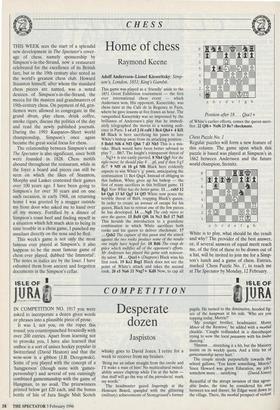CHESS
Home of chess
Raymond Keene
THIS WEEK sees the start of a splendid new development in The Spectator's cover- age of chess, namely sponsorship by Simpson's-in-the-Strand, now a restaurant celebrated for the excellence of its British fare, but in the 19th century also noted as the world's greatest chess club. Howard Staunton himself, after whom the standard chess pieces are named, was a noted denizen , of Simpson's-in-the-Strand, the mecca for the masters and grandmasters of 19th-century chess. On payment of 6d, gen- tlemen were allowed to congregate in the grand divan, play chess, drink coffee, smoke cigars, discuss the politics of the day and read the newly published journals. During the 1993 Kasparov—Short world championship, Simpson's once again became the great social focus for chess.
The relationship between Simpson's and The Spectator is also significant, since both were founded in 1828. Chess motifs abound throughout the restaurant, while in the foyer a board and pieces can still be seen on which the likes of Staunton, Morphy and Lasker contested their games over 100 years ago. I have been going to Simpson's for over 30 years and on one such occasion, in early 1968, on returning home I was greeted by a mugger outside my front door who asked me to hand over all my money. Fortified by a dinner of Simpson's roast beef and finding myself in a situation which felt much akin to being in time trouble in a chess game, I punched my assailant directly on the nose and he fled.
This week's game is not only the most famous ever played at Simpson's, it also happens to be the most famous game of chess ever played, dubbed 'the Immortal'. The notes in italics are by the loser. I have exhumed them from ancient and forgotten documents in the Simpson's cellar. Adolf Anderssen–Lionel Kieseritsky: Simp- son's, London, 1851; King's Gambit.
This game was played as a 'friendly' aside to the 1851 Great Exhibition tournament — the first ever international chess event — which Anderssen won. His opponent, Kieseritsky, was chess tutor at the Café de la Regence in Paris, where he gave lessons at five francs an hour. The vanquished Kieseritsky was so impressed by the brilliance of Anderssen's play that he immedi- ately telegraphed the moves to a waiting audi- ence in Paris. 1 e4 e5 2 f4 exf4 3 Bc4 Qh4+ 4 Kfl b5 Black is here sacrificing his pawn to lure White's bishop away from its attacking position . 5 BxbS Nf6 6 NO Qh6 7 d3 Nh5 This is a mis- take. Black would have been better advised to play 7 ... Bb7. The knight's transparent threat of ...Ng3+ is too easily parried. 8 Nh4 Qg5 Not the right move; he should play 8 ... g6, and if then 9 g3 Be7. 9 Nf5 c6 10 g4 Nf6 Black here evidently expects to win White's `g' pawn, anticipating the continuation 11 Bc4 Qxg4. Instead of obliging in this fashion, White gives up his bishop — the first of many sacrifices in this brilliant game. 11 Rgl Now White has the better game. 11 ... cxb5 12 h4 Qg6 13 h5 Qg5 14 Qf3 White now poses the terrible threat of Bxf4, trapping Black's queen. In order to create an avenue of escape for his queen, Black has to retreat one of the few pieces he has developed. 14 ... Ng8 The only move to save the queen. 15 Bxf4 Qf6 16 Nc3 Bc5 17 Nd5 This heralds the introduction to a grandiose combination in which White sacrifices both rooks and his queen to deliver checkmate. 17 Qxb2 The capture of this pawn and the attack against the two rooks produce none of the results one might have hoped for. 18 Bd6 The coup de grace which nullifies all of the opponent's efforts. Mr Anderssen has played this game with notewor- thy talent. 18 ...Qxal+ (Diagram) Black wins his first rook. 19 Ke2 Bxgl Black does not see the point of White's attack and takes the second rook. 20 e5 Na6 21 Nxg7+ Kd8 Now, to cap all Position after 18 . . . Qxal +
of White's earlier efforts, comes the queen sacri- fice. 22 Qf6+ Nxf6 23 Be7 checkmate.
Chess Puzzle No. 1 Regular puzzles will form a new feature of this column. The game upon which this puzzle is based was played at Simpson's in 1862 between Anderssen and the future world champion, Steinitz.
White is to play, what should be the result and why? The provider of the best answer, or, if several answers of equal merit reach me, of the first of these to be drawn out of a hat, will be invited to join me for a Simp- son's lunch and a game of chess. Entries, marked 'Chess Puzzle No. 1', to reach me at The Spectator by Monday, 12 February.


































































 Previous page
Previous page